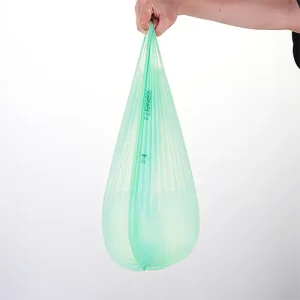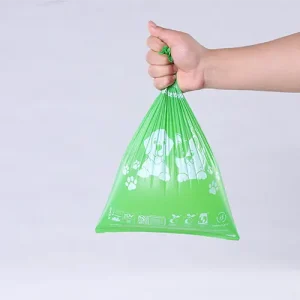Introduction
You are making an effort to manage your food scraps and yard waste by diligently using compost bags, only to discover that these bags are prone to splitting open. Given that the purpose of such bags is to contribute positively to environmental sustainability, experiencing unexpected and messy leaks can be particularly frustrating.
This article aims to equip you with practical knowledge and actionable strategies to minimize leaks and enhance your composting experience, ensuring it remains efficient and clean.

Why do Compostable Bags Leak?
To effectively prevent leakage, it is necessary to first understand the causes of the leakage. There are usually three main reasons: the nature of the compostable material itself, physical damage and the quality of the bag.
Material Degradation and Moisture:
- Compostable Means Degradable: The very reason we use biodegradable bags – their ability to break down – is also their biggest vulnerability. Compostable plastic bags aren’t designed to last forever. They’re made to decompose under specific conditions (heat, moisture, and microorganisms) within a composting facility.
- Moisture: Water is essential for the composting process, but too much moisture inside the bag accelerates decomposition and weakens the material.
- Heat’s Role: Just like moisture, heat speeds up the breakdown process. Storing your compostable bags in a warm garage or leaving them in direct sunlight can significantly reduce their lifespan, even before they’re filled with compost.
Physical Damage:
Apart from the degradability of the material, the leakage of compostable bags is often caused by physical damage.
Sharp Objects
Bags can be damaged if bones, avocado pits, branches and broken glass are accidentally inserted. Even small, seemingly harmless objects can pierce the bag.
Overfilling & Overweight the Bags
Overloading your compostable bags puts immense stress on the material, especially the seams. It’s like stretching a rubber band too far – eventually, it’s going to snap.
Even if the bag holds up inside the bin, carrying an overstuffed bag to your outdoor compost pile or collection point can be a recipe for disaster. The weight shifts, the bag stretches, and rip – you’ve got a mess on your hands.
Bag Quality and Strength:
Manufacturing Defects
While rare, manufacturing defects can occur. These might include weak seams, uneven material thickness, or small tears that are invisible to the naked eye.

Thickness
A thinner compostable bag is simply more susceptible to tearing and punctures. Think of it like a thin sheet of paper versus a thicker cardstock – the cardstock can withstand much more weight.
Material Composition
Not all compostable bags are created equal. Different biodegradable materials offer varying levels of strength and moisture resistance.
- PLA (Polylactic Acid): Derived from cornstarch, PLA is relatively rigid but can be brittle and prone to tearing, especially when wet.
- PBAT (Polybutylene Adipate Terephthalate): PBAT is a petroleum-based polymer that’s biodegradable and often blended with PLA to improve flexibility and tear resistance.
- Paper: Paper compost bags are a good choice for dealing with garbage and dry food residues in the yard. However, they have low wet strength and will decompose rapidly when exposed to moisture.
Best Practices for Preventing Compost Bags from Leaking
Now that you understand the factors that cause leakage of compost bags, let’s talk about how to defeat them. Here are some best practices to minimize the risk of leaks.
A. Choosing the Right Bags
1. Look for Certifications:
Certifications (like ASTM D6400, OK compost, and EN 13432) provide assurance that the bag has been tested and verified to meet specific standards for compostability. It’s a sign that the bag will break down effectively in a commercial composting facility.
2. Consider Thickness:
For general household food scraps, look for bags with a thickness of at least 1 mil (0.001 inch) or 25 microns. For heavier, wetter waste, consider thicker bags.
The bag’s thickness should be listed on the packaging. If it’s not, contact the manufacturer or supplier.
3. Match Bag Size to Your Container:
Choose a bag size that fits your compost bin comfortably. A bag that’s too small will be difficult to put in and take out, increasing the risk of ripping. A bag that’s too large will be wasteful.
4. Read Reviews:
Reading reviews can point you in the right direction. Before committing to a particular brand of compostable bags, take a look at online reviews. See what other users are saying about their strength, durability, and leak resistance.
B. Smart Composting Habits
1. Drain Excess Liquids:
Before tossing food scraps into your compostable bags, drain off excess liquids (coffee grounds, fruit peels, vegetable trimmings, etc.). You can use a strainer or colander to remove as much liquid as possible.
2. Wrap Wet Scraps in Paper:
Wrap particularly wet or juicy food scraps in newspaper, paper towels, or cardboard before placing them in the bag. These materials will absorb excess moisture and help keep the bag drier.
3. Avoid Sharp Objects:
Wrap sharp items like bones and avocado pits in newspaper or cardboard to protect the bag from punctures. If you generate a lot of sharp compostable waste, consider composting it separately in a more durable container or discarding it directly in your regular trash.
4. Layer with Dry Materials:
Alternate layers of wet food scraps with dry materials, such as leaves, shredded paper or wood shavings. This will help balance the moisture content in the bag and prevent it from becoming overly satureated.
5. Freeze Scraps:
In hot weather, consider freezing your food scraps before adding them to your compostable bags. This will reduce odor and slow down decomposition, giving the bag a longer lifespan.
C. Handling and Storage Techniques
1. Don’t Overfill the Bags:
Leave enough room at the top of the bag to tie it securely. Also, be mindful of the bag’s weight capacity.
2. Bag Securely and Properly
Don’t leave bags open for flies to get in. If flies get into the bags, they can lay eggs and breed there.
3. Store Bags in a Cool, Dry Place:
Compostable bags have a shelf life of one year. Keep unused bags in a cool, dry location away from direct sunlight and heat. This will prevent them from degrading prematurely.
4. Double Bag:
For particularly wet or heavy waste, consider double-bagging for extra protection.
5. Handle with Care:
When lifting and carrying compostable bags, handle them with care. Support the bottom of the bag to prevent it from tearing.

Damage Control When Leaks Happen
Despite your best efforts, leaks can still happen. Here’s how to handle them:
What to Do When the Floodgates Open
- The quick transfer to a new bag: Immediately transfer the contents of the leaking bag to a new, intact bag.
- Spill cleanup: Clean up any spills immediately to prevent odors and attract pests.
Identifying the Leak’s Origin
- Bag examination: Examine the leaking bag carefully to determine the cause of the leak. Was it a sharp object, excessive moisture, or a weak seam?
- Adjusting composting habits based on findings: Based on your findings, adjust your composting habits to prevent future leaks.
Conclusion
By understanding the vulnerabilities of compostable bags and following these best practices, you can minimize leaks and enjoy a cleaner, more efficient waste disposal experience.
Here’s a quick recap of the key tips:
- Choose certified compostable bags with adequate thickness.
- Drain excess liquids and wrap wet scraps in paper.
- Avoid sharp objects or wrap them carefully.
- Layer wet and dry materials.
- Store bags in a cool, dry place.
- Handle bags with care.
Now it’s your turn! Put these strategies into action and say goodbye to leaky compost bags for good.